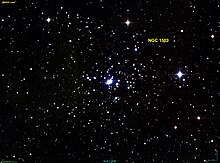 The location of NGC 1502 (circled) | |
| Observation data ( J2000 epoch) | |
|---|---|
| Right ascension | 04h 07m 48.96s [1] |
| Declination | +62° 19′ 55.2″ [1] |
| Distance | 3,452
ly (1,058.4
pc)
[1] 3,643+313 −290 ly (1,117+96 −89 pc) [2] |
| Apparent magnitude (V) | 6.0 [3] |
| Apparent dimensions (V) | 9.7′ [1] |
| Physical characteristics | |
| Radius | 5.5 ly (1.7 pc) [4] |
| Estimated age | 5 Myr [2] |
| Other designations | NGC 1502, [5] Cr 45 |
| Associations | |
| Constellation | Camelopardalis |

NGC 1502 is a young [6] open cluster of approximately 60 [3] stars in the constellation Camelopardalis, discovered by William Herschel on November 3, 1787. [7] It has a visual magnitude of 6.0 and thus is dimly visible to the naked eye. [3] This cluster is located at a distance of approximately 3,500 light years [1] [2] from the Sun, at the outer edge of the Cam OB1 association of co-moving stars, and is likely part of the Orion Arm. [2] The asterism known as Kemble's Cascade appears to "flow" into NGC 1502, but this is just a chance alignment of stars. [8]
The Trumpler class of NGC 1502 is II3p, indicating poorly populated cluster of stars (p) with a wide brightness range (3). The main sequence turnoff point is not well-defined, so the age estimates range from five to fifteen million years. [6] It is heavily reddened due to interstellar dust. [4] One of the brightest candidate members of the cluster is the eclipsing binary SZ Cam, which is a component of a visual double star ADS 2984. [2] There are eleven variable stars and four candidate variables among the cluster members, including a β Cep, two periodic B-type variables, 2–3 eclipsing variables, and an RR Lyrae star. [6] Five members of the cluster are chemically peculiar. [9]
See also
- Alpha Camelopardalis, a runaway star possibly ejected from this cluster. [6]
References
- ^ a b c d e Cantat-Gaudin, T.; Anders, F. (January 2020). "Clusters and mirages: cataloguing stellar aggregates in the Milky Way". Astronomy & Astrophysics. 633: 22. arXiv: 1911.07075. Bibcode: 2020A&A...633A..99C. doi: 10.1051/0004-6361/201936691. S2CID 208138247. A99.
- ^ a b c d e Topasna, G. A.; et al. (August 2018). "Interstellar polarization and extinction towards the young open cluster NGC 1502". Astronomy & Astrophysics. 615: 16. Bibcode: 2018A&A...615A.166T. doi: 10.1051/0004-6361/201731903. A166.
- ^ a b c O'Meara, Steve (2007). Herschel 400 Observing Guide. Cambridge University Press. p. 35. ISBN 9780521858939.
- ^ a b Tripathi, A.; et al. (September 2013). "Photometric study of Galactic open cluster NGC 2129, NGC 1502 and King 12". Bulletin of the Astronomical Society of India. 41 (3): 209. Bibcode: 2013BASI...41..209T.
- ^ "NGC 1502". SIMBAD. Centre de données astronomiques de Strasbourg. Retrieved 2022-01-10.
- ^ a b c d Michalska, G.; et al. (December 2009). "A CCD Search for Variable Stars of Spectral Type B in the Northern Hemisphere Open Clusters. VII. NGC 1502". Acta Astronomica. 59 (4): 349–370. arXiv: 0910.3672. Bibcode: 2009AcA....59..349M.
- ^ Seligman, Courtney. "Celestial Atlas: NGC Objects: NGC 1500 - 1549". cseligman.com. Retrieved 2022-01-10.
- ^ Thompson, Robert; Thompson, Barbara (2007). Illustrated Guide to Astronomical Wonders, From Novice to Master Observer. O'Reilly Media. p. 111. ISBN 9780596526856.
- ^ Paunzen, E.; et al. (November 2005). "CCD photometric search for peculiar stars in open clusters. VI. NGC 1502, NGC 3105, Stock 16, NGC 6268, NGC 7235 and NGC 7510". Astronomy and Astrophysics. 443 (1): 157–162. arXiv: astro-ph/0508151. Bibcode: 2005A&A...443..157P. doi: 10.1051/0004-6361:20053287. S2CID 17585037.
External links
-
 Media related to
NGC 1502 at Wikimedia Commons
Media related to
NGC 1502 at Wikimedia Commons - NGC 1502 on WikiSky: DSS2, SDSS, GALEX, IRAS, Hydrogen α, X-Ray, Astrophoto, Sky Map, Articles and images